(This page contains affiliate links. OGR may receive compensation if you click a link and make a purchase.)
So you recently got an eye exam and received a prescription for new glasses. Great! But…what do all those numbers and symbols mean? Does my right eye or left eye need a stronger power?
Let’s take a look.
What Does It All Mean?
A typical eyeglass prescription consists of three parts: the prescription, your pupillary distance, and an expiration date.
Common Eyeglass Prescription Abbreviations
Rx – Prescription. Rx is an abbreviation for the Latin word meaning “recipe”
OD – Right Eye. Oculus Dexter, Latin term.
OS – Left Eye. Oculus Sinister, Latin term.
SPH – Sphere – This number is the overall power in your prescription. Lens power is written in decimal form. i.e., 1.25. The unit of measurement used is called a diopter. Prescription diopters start at 0.25 and increase by increments of 0.25. For example, 0.25, 0.50, 0.75, 1.00 and so on.
CYL – Cylinder – Cylinder denotes the amount of astigmatism in your prescription. Astigmatism is a condition that bends the light as it enters your eye. This usually happens when the surface of your eye (cornea) is not perfectly spherical. Cylinder numbers also use diopters as their measurement.
Axis or “X” – This number indicates the positioning of your cylinder power within the lens. Axis numbers range from 1 to 180. The axis numbers are measured in angular degrees.
ADD – Addition -This is your reading power. This number indicates you require a magnifying power to see up close.
PD – Pupillary Distance -This is the distance between your pupils in millimeters (mm). The PD is used to position the optical center of each lens correctly in your chosen frame. Your PD can be measured either binocularly (two eyes at the same time) or monocularly (one eye at a time).
The most common PD measurement is binocular—this measurement results in one number. Monocular PDs are usually required if you will be ordering multifocal lenses, such as progressives. Monocular PD have two separate numbers, one for each eye:
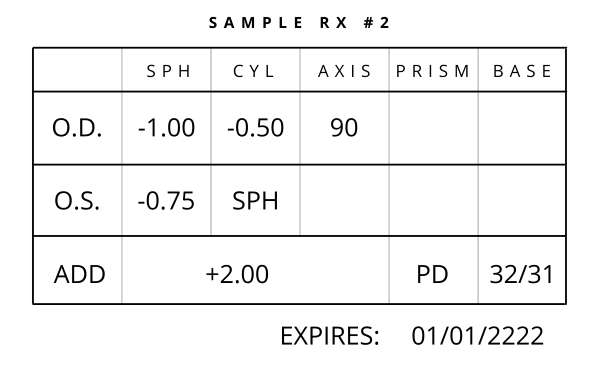
Fun fact: If you add the two numbers of your monocular PD together, they will equal your binocular PD.
PL – Plano – This means no prescription or 0.00 diopters. Some doctors will write PLANO where your sphere number would be to let the person filling your prescription know you have no power correction in that eye. You can still have an astigmatism to correct in that eye as shown below:
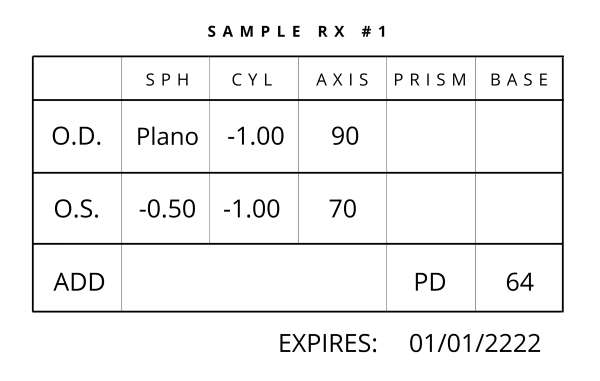
DV – Distance Vision – Some prescriptions will state “distance only,” meaning this prescription only corrects your vision for distance. When you have a “distance only” prescription, you will not find any ADD power written on your prescription (as above).
NV – Near Vision – Some prescriptions will state “reading only,” meaning this prescription is only to correct your close-up vision. If you have a “reading only” prescription, it can be written a few different ways.
- PLANO is written in the SPH space. The reading power is shown in the ADD area:
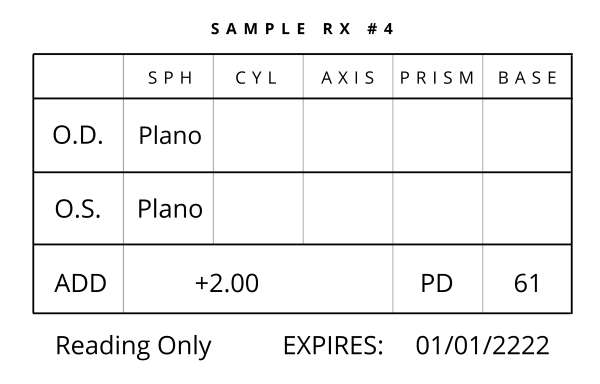
- The reading power can also be written in the SPH area. Most reading prescriptions have the same power in both eyes, but not always. Reading glasses are plus power, so the numbers will have a + sign in front:
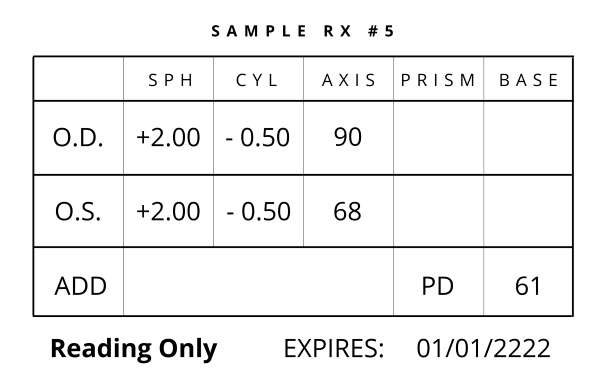
Note that this reading prescription has an astigmatism correction.
O.U. – Oculus Uterque – Meaning both eyes. Some doctors will write just one number and place O.U. behind it. The O.U. lets the person filling your prescription that you have the same power in both eyes. i.e. -3.50 O.U.
BO, BI, BU, BD- Base Out, In, Up, Down This is the direction your prism diopters are to be placed within your lens to correct your refractive error. You will only see these abbreviations if your prescription calls for a prism:
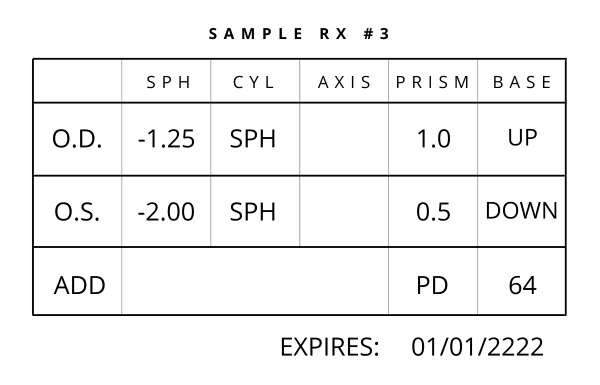
Your prescription form will have numerous columns. The form is read from left to right and top to bottom.
10 Signs You Need Reading Glasses
What Do All Those Signs Mean?
Minus (-) The minus sign in front of a number signifies the presence of myopia or nearsightedness. Myopia is when light enters your eye and focuses in front of the retina. Optimal vision occurs when light focuses on the retina. To correct this visual error, your doctor will prescribe a minus lens that will help focus the light where it needs to be on your retina.
Plus (+) – The plus sign in front of a number signifies the presence of hyperopia or farsightedness. Hyperopia is when light enters your eye and focuses behind your retina. To correct this visual error, your doctor will prescribe a plus lens or a farsighted prescription. A plus lens will redirect the light to focus directly on your retina for clear vision.
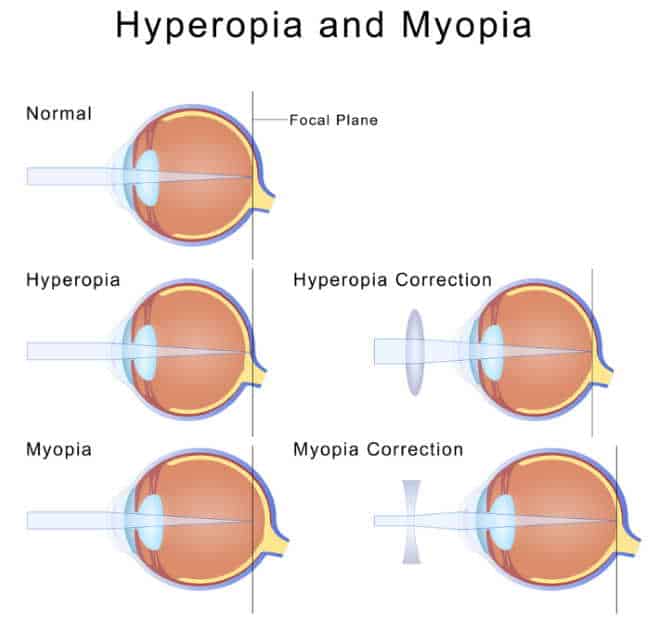
Triangle △ – The triangle is used to indicate that your prescription requires the addition of prism. Prism is used to correct various focusing errors in your vision, such as double vision. By adding prismatic power to your lenses, the light that enters your eye is bent to form one image instead of two. Prism is not a standard component of a regular prescription.
Degree symbol – Some doctors will write a degree symbol, i.e. 90°, behind the numbers of your axis. This symbol is used because the axis number is measured in angular degrees.
How Thick Will My Lenses Be?
Because myopia is corrected using concave (minus) lenses, the further from 0.00 your prescription is, the thicker your lenses will be. For example, a prescription of -5.00 will be pretty thick at the edges as opposed to a lens with a -1.00 power. Concave lenses are thinner in the middle and broader at the edges.
The opposite can be seen when you have hyperopia. A prescription of +5.00 will be thick in the center and thin at the edges. Hyperopia is corrected using convex lenses.
If you have a higher prescription, there are many thinner lens options available. You can upgrade your lenses to one of the slimmer and lighter lenses when buying your glasses.
How To Read Your Contact Lens Prescription
Why Is Your P.D. Measurement Important?

There are many reasons that an accurate PD or pupillary distance measurement is recommended.
The most important being, having an accurate PD will ensure that the optical center of your lenses are positioned properly in your frame, resulting in optimal visual acuity.
Your PD will be written on your prescription as either one number (binocular) or two separate numbers (monocular).
Binocular PD’s are the most commonly used. If you have a single vision prescription – meaning distance only or reading only – this is the PD that you will probably see on your prescription.
Monocular PDs are commonly used for digitally fabricated lenses such as multifocal, progressives and high power prescriptions.

There are various ways to measure pupillary distance. Your doctor can measure your PD using the equipment (phoropter) he used to perform your eye exam.
An optician uses either a pupilometer or a ruler to measure an accurate PD.
Your old glasses can also be read using a lensometer to copy both your existing prescription and your PD.
Why Does My Prescription Have An Expiration Date?
Your prescription is normally valid for one year from the date of your exam. In some states, eyeglass prescriptions are good for two years.
This expiration date exists because your eyes are continually changing.
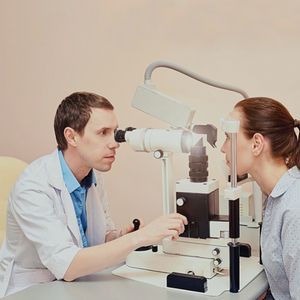
It’s important to get regular eye exams to check for any changes in your prescription as well as to evaluate the health of your eyes.
Did you know that major medical problems like diabetes and high blood pressure can be diagnosed during an eye exam?
Please note, you should not have to pay a separate charge for the doctor to hand you your prescription. This is included in the price of the exam.
You are also not obligated to purchase your eyewear at the office where you received your exam. An eye exam and an eyeglass purchase are two separate transactions.
Knowledge Is Power!
Now that you know all the terms that make up your eyeglass prescription, you can make the most informed decision when ordering your next pair of glasses. You can now decide for yourself if you want to upgrade to that thinner lens or purchase those progressive lenses instead of getting two separate pairs of glasses.
Cynthia is a published author and freelance writer that has enjoyed a career in the eyewear industry for more than 25 years. In 2016, she decided to combine her passion for writing with her experience as an Optician and launch her company, Pizzini Writes. She now dedicates her days to writing about the latest optical-related news and trends for various publications and independent retailers.
Learn more about her at www.pizziniwrites.com